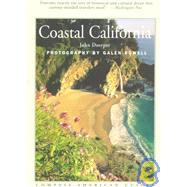
| Overview | |
| Introduction | |
| Landscape | |
| History First Immigrants Spanish Galleons and British Buccaneers Spanish Missions; Reluctant Indians Rancho Era Yankee Traders, American Settlers Gold, Vineyards, and Railroad Modern Times | |
| San Francisco Bay | |
| Travel Overview and Basics Fog and Ferry Boats on the Bay Telegraph Hill North Beach Ambling Through Chinatown Embarcadero Fisherman's Wharf Alcatraz Island Angel Island Hyde Street Pier and Aquatic Park Fort Mason and Marina Green Fort Point Golden Gate Bridge Presidio Bayside to the Pacific Beaches of San Francisco Golden Gate Park Bayside Marin County Marin Headlands Sausalito China Camp Carneros Winery Tour | |
| Marin Coast | |
| Travel Overview and Basics Heading North from San Francisco Muir Beach Stinson Beach Bolinas Lagoon and Bolinas Point Reyes National Seashore Town of Point Reyes Station Along Tomales Bay Tomales to Bodega Bay | |
| Sonoma & Mendocino | |
| Travel Overview and Basics Sonoma Coast Beaches Jenner Russian River Winery Tour Fort Ross Timber Cove to Salt Point Manchester State Beach Elk and Navarro Beach Mendocino Riviera Mendocino Anderson Valley Winery Tour Russian Gulch and Jughandle Reserve Fort Bragg MacKerricher State Park Westport | |
| Redwood Coast | |
| Travel Overview and Basics Land of Mist and Wild Scenery Lost Coast Shelter Cove Shelter Cove to Mattole River Hwy Humboldt Redwoods Mattole River Road and Beach Cape Mendocino Ferndale Eel River Delta Loleta Eureka Humboldt Bay Arcata Trinidad Patrick's Point State Park Lagoon Coast Prairie Creek Redwoods State Park Klamath River and Klamath Lagoon Creek and Yurok Loop Trail North to Crescent City Crescent City Lake Earl and Points North | |
| Golden Gate to San Simeon | |
| Travel Overview and Basics Overview of a Rural Coastline Pacifica Half Moon Bay Near San Gregorio and Pomponio Town of Pescadero Pigeon Point Point Año Nuevo State Reserve Davenport Santa Cruz South of Santa Cruz on Monterey Bay Monterey Peninsula Monterey's Fisherman's Wharf Cannery Row Monterey Bay Aquarium Pacific Grove 17-Mile Drive Carmel Carmel Valley Wineries Point Lobos Big Sur Coast Northern Big Sur Beaches and Woods Nepenthe Road to San Simeon | |
| Hearst Castle San Simeon State Beach Central Coast Riviera | |
| Travel Overview and Basics Point Mugu North Channel Islands Ventura | |
| The Banana Belt Rincon Point Rincon Point to Santa Barbara Santa Barbara What to Do and See in Santa Barbara UC Santa Barbara Goleta Point Refugio State Beach Santa Ynez and Santa Maria Valley Winery Tours Point Conception Lompoc Guadalupe-Nipomo Dunes Pismo Beach San Luis Bay Pecho Coast Trail San Luis Obispo History and Ambiance Visiting San Luis Obispo Arroyo Grande-Edna Valley Winery Tour York Mountain-Templeton Winery Tour Morro Bay What to Do a | |
| Table of Contents provided by Publisher. All Rights Reserved. |
The New copy of this book will include any supplemental materials advertised. Please check the title of the book to determine if it should include any access cards, study guides, lab manuals, CDs, etc.
The Used, Rental and eBook copies of this book are not guaranteed to include any supplemental materials. Typically, only the book itself is included. This is true even if the title states it includes any access cards, study guides, lab manuals, CDs, etc.
Excerpted from Coastal California by John Doerper
All rights reserved by the original copyright owners. Excerpts are provided for display purposes only and may not be reproduced, reprinted or distributed without the written permission of the publisher.